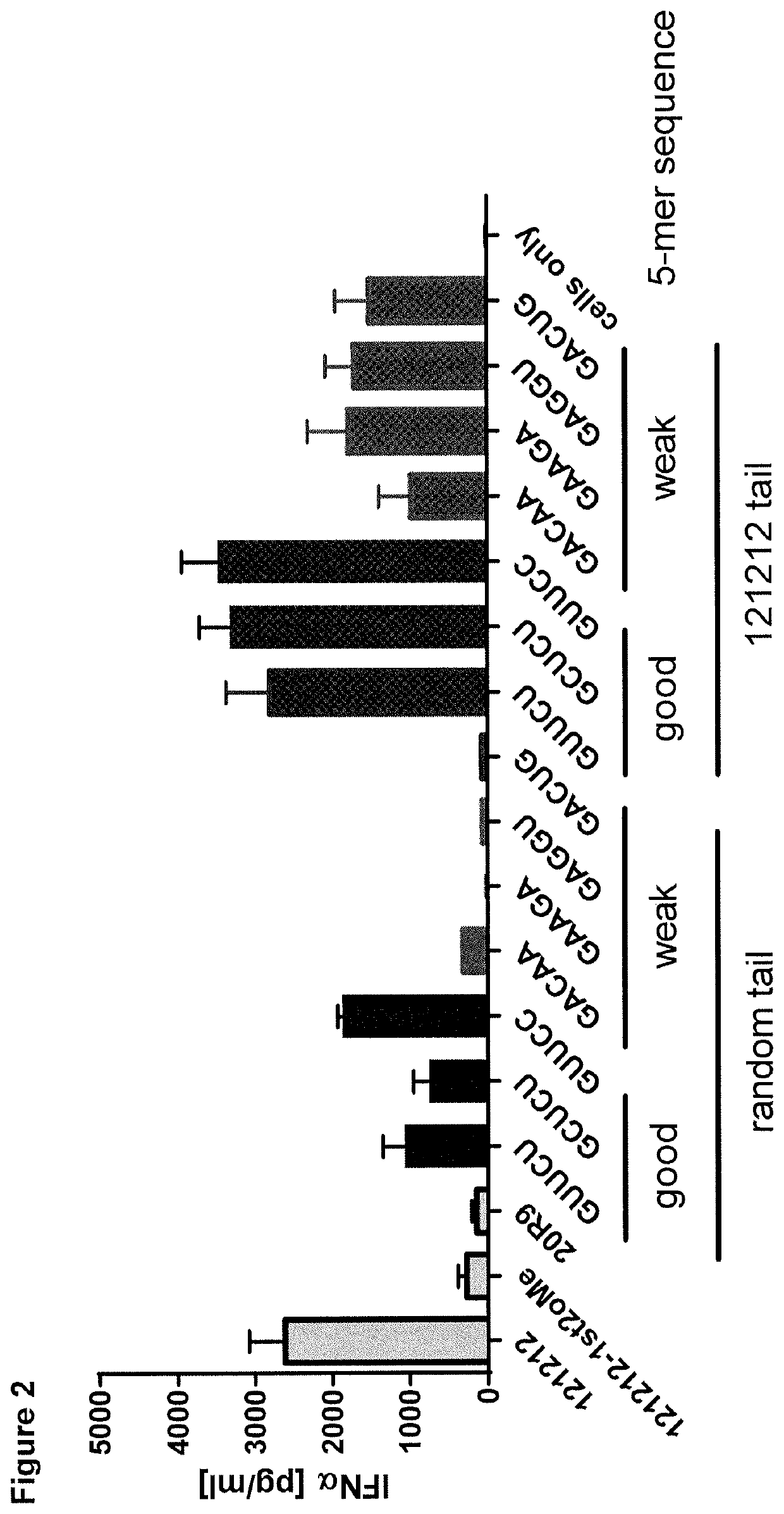Method for designing RIG-I ligands
a ligand and design method technology, applied in the direction of viral antigen ingredients, sugar derivatives, organic active ingredients, etc., can solve the problems of rna sequence-specific signature decoding remains largely unknown, and the nucleotide sequence exchange can negatively affect stimulatory activity, so as to achieve high type-i ifn inducing activity
- Summary
- Abstract
- Description
- Claims
- Application Information
AI Technical Summary
Benefits of technology
Problems solved by technology
Method used
Image
Examples
example 1-5 ′
Example 1-5′-Sequences Influence on Immune Activation
[0240]Nucleic acid sensors efficiently trigger anti-viral and anti-cancer immune pathways to strengthen the body's defense mechanisms. Pharmacological activation of nucleic acid sensors such as TLRs and RIG-I emerged them as attractive targets to recover host homeostasis (Junt and Barchet, 2015, Nat Rev Immunol). Recent studies highlight structural features determining RIG-I activation: the phosphorylation status at the very 5′ end (Schlee et al, Goubau et al), the oligonucleotide length (Schlee) and the 5′ nucleotide (Schlee).
[0241]Structural determinants distinguishing strong from weak RIG-I ligands remain largely elusive and thus we aimed to analyze the influence of different 5-mer sequences at the very 5′-end sensed by RIG-I's basic patch region. Therefore, sixty 5-mer sequences with a G / C content ranging from 40-80% were generated randomly Subsequently, all 5-mer sequences were linked to a 19-mer random tail (5′-UGGAUGGUUGGCU...
example 2
l Boxes Reside within the Tail Sequence and Regulate Immune Activation
[0245]The role of tail sequence inherent features had not been investigated as of yet. Thus, to explore whether functional structural elements within 19-mer tail sequence exist and how these might shape the immune response, the 121212 tail sequence was modified stepwise. Single or more 4-mer sequences were substituted by corresponding 4-mer cassettes derived from the random tail (5′-UGGAUGGUUGGCUAGGAUA-3′ (SEQ ID NO: 28)) (FIG. 3A). Analysis of these novel dsRNA sequences revealed that 4-mer substitutions at positions 8-11, 16-19, 20-23, 8-15, 16-23, 8-11 / 16-19, 8-11 / 20-23 and 12-19 (counted from the very 5′ end of the RNA included the 5-mer sequence) are detrimental and negatively regulate RIG-I-induced IFNα release (FIG. 3B). We then set out to narrow down crucial sequence sections by changing single nucleotides within the 19-mer 121212 tail. In particular, nucleotide substitutions at the positions 6, 8, 17 and ...
example 3
Structural Features to Create a Design Rule for Optimal RIG-I Agonism
[0247]Intense studies on optimal 5′ 5-mer sequences and intramolecular nucleotide substitutions revealed important structural elements accounting for RIG-I agonism as described above. All elements identified were applied to a 24-mer sequence as shown in FIG. 6. The very 5′ consensus 5-mer sequence is shown in the very left box. Regions 6-8 and 17-19 were assigned as box 1 (middle) and box 2 (very right), respectively and accepted nucleotide substituents with minor effects on immune stimulation are shown below. Moreover, detrimental nucleotide doublets in box 1 and their exact positions are indicated. Furthermore, adenosine at position 9 is highlighted (FIG. 6).
[0248]Here we presented the development of a novel design rule to predict highly versatile RIG-I-ligands. We identified a consensus 5-mer cassette (5′-G1-noA2-U3-C4-N5-3′) and a 19-mer tail sequence comprising two 3-nt boxes located at positions 6-8 (box 1) a...
PUM
| Property | Measurement | Unit |
|---|---|---|
| angle | aaaaa | aaaaa |
| area | aaaaa | aaaaa |
| time | aaaaa | aaaaa |
Abstract
Description
Claims
Application Information
 Login to View More
Login to View More - R&D
- Intellectual Property
- Life Sciences
- Materials
- Tech Scout
- Unparalleled Data Quality
- Higher Quality Content
- 60% Fewer Hallucinations
Browse by: Latest US Patents, China's latest patents, Technical Efficacy Thesaurus, Application Domain, Technology Topic, Popular Technical Reports.
© 2025 PatSnap. All rights reserved.Legal|Privacy policy|Modern Slavery Act Transparency Statement|Sitemap|About US| Contact US: help@patsnap.com



